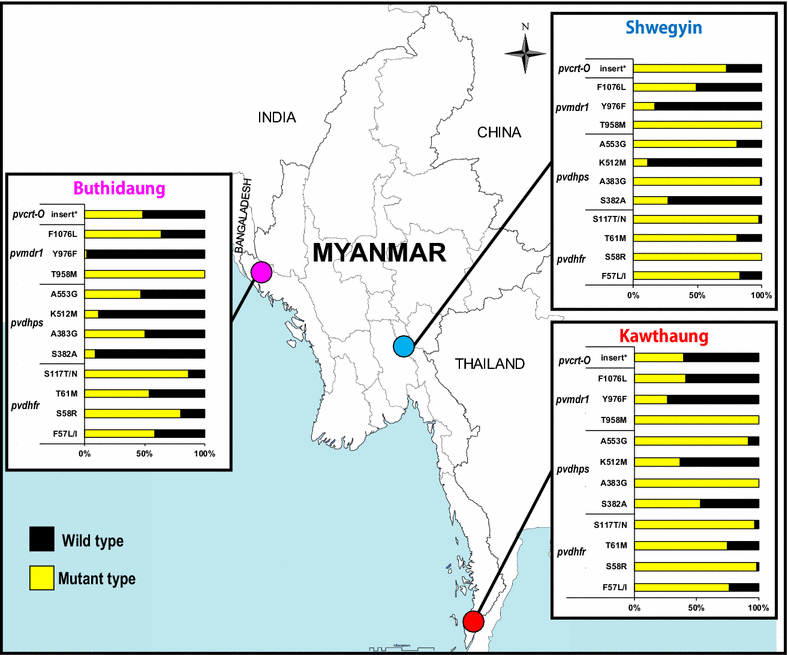Clinical and molecular surveillance of drug resistant vivax malaria in Myanmar (2009-2016)
- PMID: 28298235
- PMCID: PMC5353783
- DOI: 10.1186/s12936-017-1770-7
Clinical and molecular surveillance of drug resistant vivax malaria in Myanmar (2009-2016)
Abstract
Background: One of the major challenges for control and elimination of malaria is ongoing spread and emergence of drug resistance. While epidemiology and surveillance of the drug resistance in falciparum malaria is being explored globally, there are few studies on drug resistance vivax malaria.
Methods: To assess the spread of drug-resistant vivax malaria in Myanmar, a multisite, prospective, longitudinal study with retrospective analysis of previous therapeutic efficacy studies, was conducted. A total of 906 from nine study sites were included in retrospective analysis and 208 from three study sites in prospective study. Uncomplicated vivax mono-infected patients were recruited and monitored with longitudinal follow-up until day 28 after treatment with chloroquine. Amplification and sequence analysis of molecular markers, such as mutations in pvcrt-O, pvmdr1, pvdhps and pvdhfr, were done in day-0 samples in prospective study.
Results: Clinical failure cases were found only in Kawthaung, southern Myanmar and western Myanmar sites within 2009-2016. Chloroquine resistance markers, pvcrt-O 'AAG' insertion and pvmdr1 mutation (Y976F) showed higher mutant rate in southern and central Myanmar than western site: 66.7, 72.7 vs 48.3% and 26.7, 17.0 vs 1.7%, respectively. A similar pattern of significantly higher mutant rate of antifolate resistance markers, pvdhps (S382A, K512M, A553G) and pvdhfr (F57L/I, S58R, T61M, S117T/N) were noted.
Conclusions: Although clinical failure rate was low, widespread distribution of chloroquine and antifolate resistance molecular makers alert to the emergence and spread of drug resistance vivax malaria in Myanmar. Proper strategy and action plan to eliminate and contain the resistant strain strengthened together with clinical and molecular surveillance on drug resistance vivax is recommended.
Keywords: Drug resistance; Malaria; Molecular surveillance; Myanmar; Plasmodium vivax.
Figures


Similar articles
-
Molecular surveillance for drug resistance markers in Plasmodium vivax isolates from symptomatic and asymptomatic infections at the China-Myanmar border.Malar J. 2020 Aug 5;19(1):281. doi: 10.1186/s12936-020-03354-x. Malar J. 2020. PMID: 32758218 Free PMC article.
-
Polymorphisms of potential drug resistant molecular markers in Plasmodium vivax from China-Myanmar border during 2008‒2017.Infect Dis Poverty. 2022 Apr 25;11(1):43. doi: 10.1186/s40249-022-00964-2. Infect Dis Poverty. 2022. PMID: 35462549 Free PMC article.
-
Prevalence and patterns of antifolate and chloroquine drug resistance markers in Plasmodium vivax across Pakistan.Malar J. 2013 Sep 5;12:310. doi: 10.1186/1475-2875-12-310. Malar J. 2013. PMID: 24007534 Free PMC article.
-
[Research progress on Plasmodium vivax chloroquine resistance].Zhongguo Xue Xi Chong Bing Fang Zhi Za Zhi. 2014 Jun;26(3):326-31. Zhongguo Xue Xi Chong Bing Fang Zhi Za Zhi. 2014. PMID: 25345166 Review. Chinese.
-
Chemotherapeutic hope on the horizon for Plasmodium vivax malaria?Proc Natl Acad Sci U S A. 2002 Oct 15;99(21):13362-4. doi: 10.1073/pnas.232483699. Epub 2002 Oct 8. Proc Natl Acad Sci U S A. 2002. PMID: 12374849 Free PMC article. Review. No abstract available.
Cited by
-
Investigation of Mutations in the crt-o and mdr1 Genes of Plasmodium vivax for the Molecular Surveillance of Chloroquine Resistance in Parasites from Gold Mining Areas in Roraima, Brazil.Microorganisms. 2024 Aug 15;12(8):1680. doi: 10.3390/microorganisms12081680. Microorganisms. 2024. PMID: 39203521 Free PMC article.
-
Characterization of Plasmodium vivax pvmdr1 Polymorphisms in Isolates from Mangaluru, India.Am J Trop Med Hyg. 2019 Aug;101(2):416-417. doi: 10.4269/ajtmh.19-0224. Am J Trop Med Hyg. 2019. PMID: 31218998 Free PMC article.
-
Molecular Surveillance and Ex Vivo Drug Susceptibilities of Plasmodium vivax Isolates From the China-Myanmar Border.Front Cell Infect Microbiol. 2021 Nov 1;11:738075. doi: 10.3389/fcimb.2021.738075. eCollection 2021. Front Cell Infect Microbiol. 2021. PMID: 34790586 Free PMC article.
-
Therapeutic efficacy of chloroquine for uncomplicated Plasmodium vivax malaria in southeastern and western border areas of Myanmar.Infection. 2022 Jun;50(3):681-688. doi: 10.1007/s15010-021-01739-x. Epub 2022 Jan 16. Infection. 2022. PMID: 35034327 Free PMC article.
-
Molecular surveillance for drug resistance markers in Plasmodium vivax isolates from symptomatic and asymptomatic infections at the China-Myanmar border.Malar J. 2020 Aug 5;19(1):281. doi: 10.1186/s12936-020-03354-x. Malar J. 2020. PMID: 32758218 Free PMC article.
References
-
- WHO. World Malaria Report 2015. Geneva: World Health Organization; 2015.
-
- WHO. Control and elimination of Plasmodium vivax malaria: a technical brief. Geneva: World Health Organization; 2015.
-
- WHO. Methods for surveillance of antimalarial drug efficacy. Geneva: World Health Organization; 2009.
-
- PlasmoDB—Plasmodium genomics resource. [http://plasmodb.org]. Accessed 2 Mar 2017.
Publication types
MeSH terms
Substances
LinkOut - more resources
Full Text Sources
Other Literature Sources

